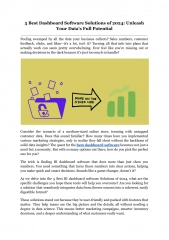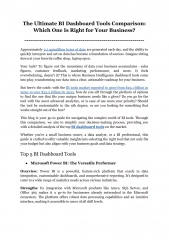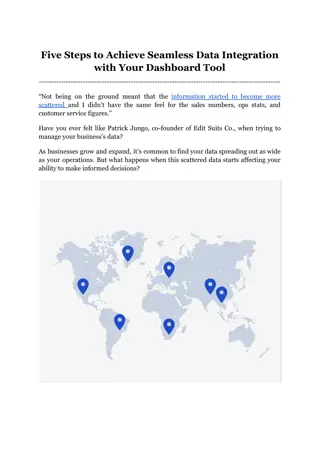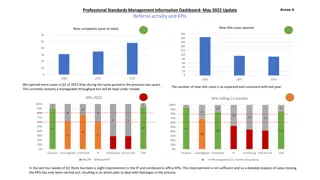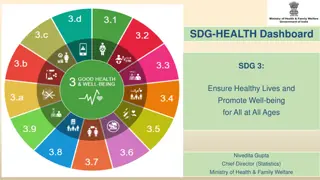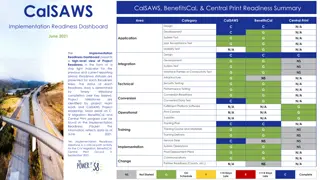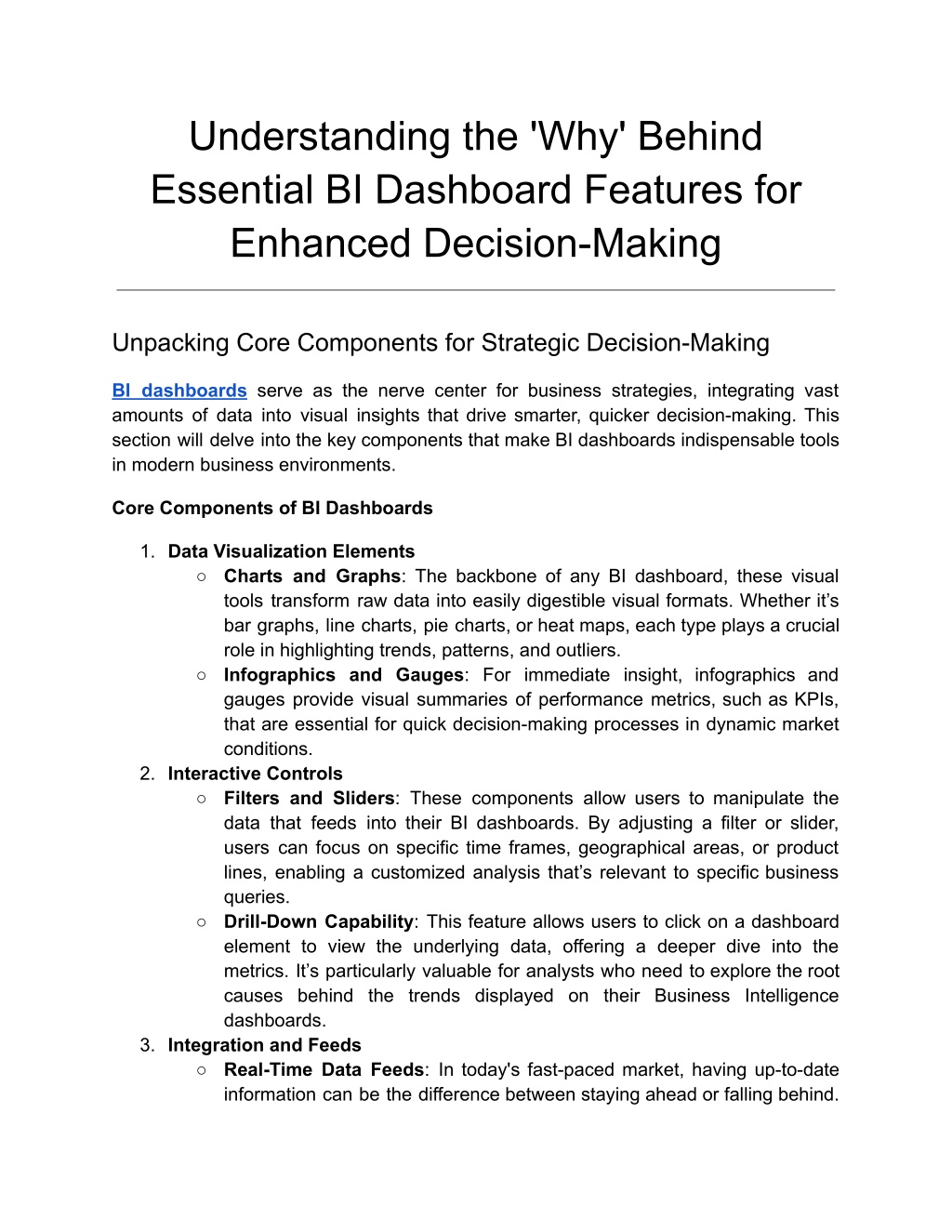
Understanding the 'Why' Behind Essential BI Dashboard Features for Enhanced Decision-Making
Unpack the deeper logic of BI dashboards and their features in this incisive blog post. We delve into why each component is critical in sculpting more informed, data-driven business strategies. Whether you're enhancing existing skills or cultivating
Download Presentation

Please find below an Image/Link to download the presentation.
The content on the website is provided AS IS for your information and personal use only. It may not be sold, licensed, or shared on other websites without obtaining consent from the author. Download presentation by click this link. If you encounter any issues during the download, it is possible that the publisher has removed the file from their server.
E N D
Presentation Transcript
Understanding the 'Why' Behind Essential BI Dashboard Features for Enhanced Decision-Making Unpacking Core Components for Strategic Decision-Making BI dashboards serve as the nerve center for business strategies, integrating vast amounts of data into visual insights that drive smarter, quicker decision-making. This section will delve into the key components that make BI dashboards indispensable tools in modern business environments. Core Components of BI Dashboards 1. Data Visualization Elements Charts and Graphs: The backbone of any BI dashboard, these visual tools transform raw data into easily digestible visual formats. Whether it s bar graphs, line charts, pie charts, or heat maps, each type plays a crucial role in highlighting trends, patterns, and outliers. Infographics and Gauges: For immediate insight, infographics and gauges provide visual summaries of performance metrics, such as KPIs, that are essential for quick decision-making processes in dynamic market conditions. 2. Interactive Controls Filters and Sliders: These components allow users to manipulate the data that feeds into their BI dashboards. By adjusting a filter or slider, users can focus on specific time frames, geographical areas, or product lines, enabling a customized analysis that s relevant to specific business queries. Drill-Down Capability: This feature allows users to click on a dashboard element to view the underlying data, offering a deeper dive into the metrics. It s particularly valuable for analysts who need to explore the root causes behind the trends displayed on their Business Intelligence dashboards. 3. Integration and Feeds Real-Time Data Feeds: In today's fast-paced market, having up-to-date information can be the difference between staying ahead or falling behind.
Mobile BI dashboards are particularly effective at integrating real-time data feeds, ensuring that decision-makers have the most current information at their fingertips, no matter where they are. APIs and Data Connectors: Effective BI dashboards seamlessly integrate with various data sources through APIs and connectors. This integration ensures that data flows from CRM systems, ERP software, and other data repositories into the BI dashboard tool without manual intervention, maintaining data integrity and timeliness. 4. Customization and Personalization User-Specific Dashboards: Modern BI dashboard tools offer extensive customization options to cater to different user roles and preferences. From a C-suite executive needing a high-level overview of corporate performance to an operations manager monitoring daily production stats, each dashboard can be tailored to meet individual requirements. Theme and Design Options: Aesthetics matter, not just for user satisfaction but also for readability and usability. Custom themes and design options help align the dashboard s visual elements with company branding and user preferences, enhancing the overall user experience of the BI dashboard tool.
Feature Focus: Customization in BI Dashboards Customizable BI dashboards allow businesses to adapt their intelligence tools to specific data needs and decision-making processes, enhancing usability and relevance. This capability directly impacts operational efficiency and strategic insights, enabling businesses to reflect their unique metrics and KPIs that are vital to their success. For instance, while a retail company might focus on customer acquisition costs, a manufacturing firm may prioritize production cycle times. BI dashboards offer the flexibility to update and modify KPIs as business strategies evolve, supporting agile decision-making without the need for backend coding. Furthermore, customization extends to role-based dashboard views which enhance security and focus by ensuring that individuals from the CEO to frontline sales staff only access data pertinent to their roles. For example, a sales manager using a mobile BI dashboard can access real-time data specific to their geographic region directly on their mobile device, ensuring they have the most relevant information at their fingertips. Interactive data exploration is another significant aspect of BI dashboard customization. Features like drill-down and drill-through allow users to explore beyond surface-level data, which is invaluable for analysts who need to uncover root causes or deeper insights. Additionally, scenario analysis capabilities within BI dashboards enable users to manipulate data to model various business scenarios, aiding in forecasting and strategic planning. Visual customization and branding are equally important; they not only reinforce brand identity but also improve dashboard usability. Custom themes, colors, and layouts make the dashboards more intuitive and visually appealing, which can lead to higher user adoption rates. The ability to configure widgets and components to suit specific analytical needs and user preferences further enhances this effect.
The impact of such customization includes increased adoption and productivity, as dashboards that closely reflect user needs are more widely used, promoting data-driven decision-making across the organization. Moreover, customized BI dashboards provide relevant data in the most effective formats, enabling faster analysis and informed decision-making, which is crucial in high-stakes or rapidly changing environments. Feature Focus: Real-time Data Integration Integrating real-time data into BI dashboards is essential, not merely an added feature. Real-time data integration empowers companies to respond instantly to market shifts and internal changes, enabling a proactive approach to business strategy. This capability is critical in environments like financial markets or consumer-driven sectors where conditions are constantly evolving. Real-time data integration in BI dashboards involves the continuous ingestion of data, ensuring that the most current information is always at hand for immediate display and analysis. The technical foundation of this feature includes the use of APIs and webhooks, which pull data from various sources as soon as it becomes available. Additionally, data streaming technologies allow BI dashboard tools to process and display information instantaneously, providing an up-to-the-minute view of business operations or market conditions.
The impact of real-time data on business operations is profound. For example, it enables companies to monitor and react to customer interactions as they occur, adjust quickly to supply chain disruptions, or capitalize on market trends immediately as they emerge. A practical application of this can be seen in a retail chain that uses real-time data on its mobile BI dashboards to adjust pricing and promotions based on live sales performance, significantly enhancing profitability during peak periods. Different industries reap distinct benefits from real-time data integration. In the financial sector, it allows for the immediate tracking of stock fluctuations, aiding traders and analysts in making swift, informed decisions. In healthcare, real-time data facilitates quicker responses to patient needs and more efficient resource allocation, directly impacting patient care and operational efficiency. However, the integration of real-time data is not without challenges. Ensuring the accuracy and integrity of incoming data in real-time requires robust validation processes. Automated data quality checks can help by flagging discrepancies as data enters the system. Moreover, the management of substantial real-time data flows necessitates the use of highly scalable BI dashboard tools. Cloud-based infrastructures and advanced data processing algorithms can scale dynamically with data inflows, addressing issues related to system performance. Feature Focus: Collaborative Tools Collaborative tools within BI dashboards transform these platforms from mere data visualization tools into dynamic environments where teams can communicate, share insights, and make collective decisions. These features are crucial for enhancing teamwork and improving decision-making processes across various business settings. Interactive commenting and annotation functionalities allow team members to engage directly with the data by discussing points and marking up specific visualizations within the BI dashboard. This capability bridges the gap between data analysis and decision-making, fostering a shared understanding among stakeholders. For example, a data analyst might highlight an unexpected dip in performance metrics and initiate a discussion within the same dashboard, which can lead to quicker resolution and strategic actions. Simultaneous viewing and interaction by multiple users on BI dashboards are made possible through real-time collaboration features. Changes made by any user are immediately visible to all, ensuring that every team member is on the same page. This is invaluable for remote or geographically dispersed teams, as it supports synchronous workflows and decision-making, guaranteeing that decisions are made based on the latest data.
BI dashboards also offer shared dashboard capabilities and custom access controls, allowing organizations to manage visibility according to role and necessity. For instance, while departmental heads may access broad business intelligence dashboards, individual contributors might only see dashboards that pertain to their direct roles. This ensures that sensitive information is protected while still fostering an inclusive environment where a data-driven culture can thrive. Additionally, BI dashboards can be equipped with an automated alerts and notifications system to inform team members about significant data changes or achievements. This feature is crucial for maintaining awareness of key metrics without constant manual monitoring. For example, a significant drop in online engagement might trigger an automated alert to the marketing team s mobile BI dashboards, prompting them to investigate and respond promptly. Many BI dashboard tools are designed to integrate seamlessly with existing business communication tools such as email, chat applications, and project management software. This integration facilitates smooth information flow across different platforms, streamlining workflows, and enhancing communication efficiency. This connectivity ensures that insights gleaned from BI dashboards can be quickly turned into actionable strategies across various business functions. Feature Focus: Accessibility and Mobile Readiness The accessibility and mobile readiness of BI dashboards are not mere conveniences but necessities. These features ensure that decision-makers can access critical data and insights anytime and anywhere, fostering a dynamic and responsive business culture. This analysis delves into how BI dashboard tools are enhancing their accessibility and mobile readiness to meet the demands of modern businesses, ensuring effective data leverage across various devices and locations. Responsive design is pivotal in BI dashboards, ensuring that the dashboard interface and visualizations adapt seamlessly across different devices, from desktops to mobile phones. This adaptability maintains functionality and readability without compromising detail or usability. For instance, a business analyst can begin their day reviewing key metrics on a desktop at the office and seamlessly continue on their smartphone during off-site meetings, experiencing no loss in data fidelity or functionality. Moreover, touch optimization is critical for mobile BI dashboards, making navigation and interaction with data effortless on touch-based devices. This optimization enhances the user experience by making data exploration intuitive, crucial for executives and field personnel who predominantly use mobile devices for business activities. Alongside, effective BI dashboards ensure cross-platform compatibility, operating flawlessly across
different operating systems like iOS, Android, or Windows. This universal compatibility ensures that every team member, regardless of their device preference, has consistent and unfettered access to business intelligence dashboards, promoting unified decision-making across the organization. However, increased accessibility raises concerns about data security, especially on mobile devices that are susceptible to loss or theft. To address this, BI dashboards incorporate advanced security measures like biometric authentication and end-to-end encryption to protect sensitive data accessed from mobile devices. These security measures ensure that, even if a device is compromised, the integrity and confidentiality of the data remain intact. Lastly, considering the occasional unreliability of internet connectivity, especially in remote areas or while traveling, some BI dashboard tools offer offline access. This feature allows users to download data snapshots that can be interacted with without an internet connection, ensuring that decision-making processes are not interrupted by connectivity issues. Feature Dashboards Focus: Accessibility and Mobile Readiness in BI The advantageous they are imperative. These features ensure that decision-makers and team members can access critical business data continuously and seamlessly, empowering them to make informed decisions no matter where they are. This capability is crucial in enhancing business operations and caters specifically to the needs of business users, data analysts, and BI professionals. accessibility and mobile readiness of BI dashboards are not just Responsive design is essential in BI dashboards, as it allows the interface to automatically adjust to fit the screen of any device, whether desktop, tablet, or smartphone. This flexibility ensures that visual data is displayed correctly and remains easy to interpret, which is vital for facilitating quick and effective decision-making on any device. An optimized user experience on various devices not only increases productivity but also boosts engagement with the BI dashboard tool, ensuring full functionality is available on the go. Furthermore, touch optimization is paramount in mobile BI dashboards. It ensures that users can interact with their dashboards through simple touches and gestures, like swiping and pinching, which are intuitive on touch devices. This functionality allows field agents and remote workers to modify filters, drill down into data, or interact with
complex datasets effortlessly, without the need for traditional input devices, enhancing operational efficiency in mobile settings. Cross-platform accessibility is another critical aspect of modern BI dashboards. Ensuring that these tools perform uniformly across different platforms and operating systems is crucial for businesses utilizing a variety of technological solutions. Whether employees are using iOS, Android, or Windows devices, they should be able to access the same powerful features and comprehensive data insights, which promotes consistency and eliminates data silos within the organization. With the increase in mobile usage, securing sensitive business data on mobile devices has become paramount. Implementing robust security measures such as multi-factor authentication, secure data encryption, and secure mobile access points ensures that sensitive data is protected. These security features not only safeguard data but also build trust among users and ensure compliance with international data protection regulations, which is essential for businesses operating across borders. Mobile BI dashboards equipped with offline capabilities offer significant advantages. These dashboards allow users to download reports and data to their devices, enabling access and analysis even without an internet connection. This feature is invaluable during travel or in areas with unreliable decision-making and productivity are not disrupted. internet connectivity, ensuring that Advanced Analytics and Predictive Features BI dashboards enhanced with advanced analytics and predictive features are revolutionizing the way businesses approach decision-making. These tools not only analyze current data but also predict future trends, providing businesses with the foresight needed to make strategic decisions proactively. This in-depth exploration focuses on how integrating advanced analytics and predictive features into BI dashboards significantly boosts operational efficiency and strategic planning for business users, data analysts, and BI professionals. Advanced analytics in BI dashboards utilize sophisticated algorithms capable of processing large datasets efficiently, revealing meaningful patterns and trends that go unnoticed with conventional analysis methods. For example, BI dashboards can employ statistical models to discern purchasing behaviors over time, enabling retailers to optimize their inventory in alignment with anticipated sales trends. Additionally, these dashboards incorporate data mining techniques and machine learning algorithms that enhance their analytical capabilities. These technologies adapt and learn from ongoing data patterns, improving their accuracy and applicability in predictive modeling, which forecasts future customer behavior based on historical data. This functionality is
invaluable for tailoring marketing strategies and enhancing customer engagement effectively. Predictive features in BI dashboards leverage historical data to forecast future events using advanced statistical methods and machine learning models. In the financial sector, for instance, these tools can predict market fluctuations, aiding investment managers in making informed asset management decisions. BI dashboards also facilitate scenario analysis, allowing users to manipulate various input variables to project how these changes might affect future outcomes. Such analyses are crucial for strategic planning and risk management, helping companies navigate potential economic impacts on their revenue streams. The integration of these predictive features into mobile BI dashboards has further transformed their utility, ensuring that decision-makers have access to critical predictive insights in real-time, irrespective of responsiveness and agility, allowing executives to make pivotal decisions on-the-fly. Furthermore, the user interfaces of these predictive features are designed for ease of use, presenting complex data and forecasts in an accessible format that even non-technical users can easily understand and utilize. This approach not only increases the adoption of BI dashboard tools across various organizational levels but also democratizes data access, empowering a broader range of employees to engage with data-driven decision-making processes. their location. This mobility enhances Conclusion In wrapping up, delving into the rationale behind each element of BI dashboards unlocks their true potential, turning raw data into a goldmine of actionable insights. As your organization navigates the intricate webs of data-driven decision landscapes, having the right analytical tools is paramount. Grow emerges as a beacon for this journey, offering a platform that not only simplifies but also magnifies your data's strategic value. Initiate your path to deeper insights by exploring Grow with our no-cost 14-day trial. Experience how our sophisticated BI solutions can refine your approach to data analysis and elevate your strategic outcomes. For insights on how Grow equips businesses to excel and an in-depth look at its cost-effectiveness and robust functionalities, visit "Grow Reviews Cost & Features GetApp." Learn from existing users why Grow is celebrated in the realm of BI tools, empowering organizations to flourish in an information-driven era. Transform complexity into clarity with Grow. Activate your trial today and harness the power of data tailored to propel your business forward.

